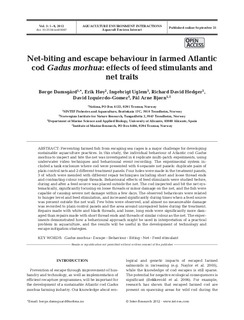| dc.contributor.author | Damsgård, Børge | |
| dc.contributor.author | Høy, Erik | |
| dc.contributor.author | Uglem, Ingebrigt | |
| dc.contributor.author | Hedger, Richard | |
| dc.contributor.author | Izquierdo-Gomez, David | |
| dc.contributor.author | Bjørn, Pål Arne | |
| dc.date.accessioned | 2018-08-01T06:53:28Z | |
| dc.date.available | 2018-08-01T06:53:28Z | |
| dc.date.created | 2012-11-15T15:11:58Z | |
| dc.date.issued | 2012 | |
| dc.identifier.citation | Aquaculture Environment Interactions. 2012, 3 (1), 1-9. | |
| dc.identifier.issn | 1869-215X | |
| dc.identifier.uri | http://hdl.handle.net/11250/2507054 | |
| dc.description.abstract | reventing farmed fish from escaping sea cages is a major challenge for developing sustainable aquaculture practices. In this study, the individual behaviour of Atlantic cod Gadus morhua to inspect and bite the net was investigated in 4 replicate multi-patch experiments, using underwater video techniques and behavioural event recording. The experimental system in - cluded a tank enclosure where cod were presented with 6 separate net panels: duplicate pairs of plain control nets and 2 different treatment panels. Four holes were made in the treatment panels, 3 of which were mended with different repair techniques including short and loose thread ends and contrasting colour repair threads. Behavioural effects of feed stimulants were studied before, during and after a feed source was placed outside the net. The cod inspected and bit the net systematically, significantly focusing on loose threads or minor damage on the net, and the fish were capable of causing severe net damage within a few days. The observed behaviours were related to hunger level and feed stimulation, and increased significantly during times when a feed source was present outside the net wall. Few bites were observed, and almost no measureable damage was recorded to plain control panels and the area around unrepaired holes during the treatment. Repairs made with white and black threads, and loose, long ends were significantly more damaged than repairs made with short thread ends and threads of similar colour as the net. The experiments demonstrated how a behavioural approach might be used in interpretation of a practical problem in aquaculture, and the results will be useful in the development of technology and escape mitigation strategies. Gadus morhua · Escape · Behaviour · Biting · Net · Feed stimulant | |
| dc.description.abstract | Net-biting and escape behaviour in farmed Atlantic cod Gadus morhua: effects of feed stimulants and net traits | |
| dc.language.iso | eng | |
| dc.title | Net-biting and escape behaviour in farmed Atlantic cod Gadus morhua: effects of feed stimulants and net traits | |
| dc.title.alternative | Net-biting and escape behaviour in farmed Atlantic cod Gadus morhua: effects of feed stimulants and net traits | |
| dc.type | Peer reviewed | |
| dc.type | Journal article | |
| dc.description.version | publishedVersion | |
| dc.source.pagenumber | 1-9 | |
| dc.source.volume | 3 | |
| dc.source.journal | Aquaculture Environment Interactions | |
| dc.source.issue | 1 | |
| dc.identifier.doi | 10.3354/aei00047 | |
| dc.identifier.cristin | 962488 | |
| cristin.unitcode | 7543,1,5,0 | |
| cristin.unitname | Produksjonsbiologi | |
| cristin.ispublished | true | |
| cristin.fulltext | original | |
| cristin.qualitycode | 1 | |
